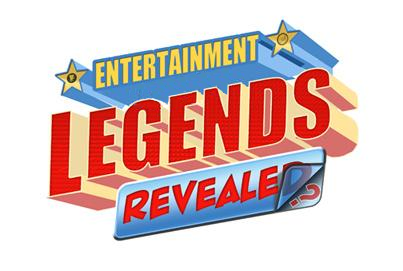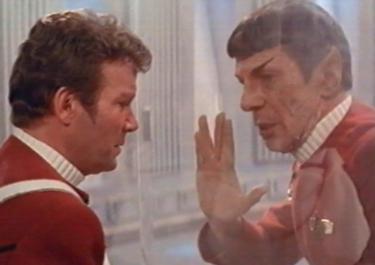Did Leonard Nimoy Request For Spock to Be Killed Off in Star Trek II: The Wrath of Khan?
Here is the latest in a series of examinations into urban legends about movies and whether they are true or false. Click here to view an archive of the movie urban legends featured so far.
MOVIE URBAN LEGEND: Leonard Nimoy requested that Spock be killed off if Nimoy was to play Spock again in Star Trek II: The Wrath of Khan.
Norm Macdonald has an old joke about the time he met a guy at a bar and they ended up drinking so much that when Macdonald woke up the next day, he was in a rehab facility. As it turns out, the guy he was drinking with was an alcoholic who presumed that Macdonald was one, as well, so he checked them both in to rehab. As Macdonald jokes, he tried to explain to the people at the facility that he was not an alcoholic, but as it turns out, that’s apparently exactly what alcoholics say, as well. That has been the situation that Leonard Nimoy has been dealing with for over thirty years with regards to the long-standing legend that Nimoy requested that Spock be killed off in Star Trek II: The Wrath of Khan.
He’s been denying it for decades, but people figure that he would deny it even if it were true, so his denials have not held much weight. So let’s try to settle it as best as we can this week. Did Leonard Nimoy request for Spock to be killed off if Nimoy were to return to play the character in Star Trek II: The Wrath of Khan? Read on to find out!
Simply put, no. Less simply put, well, that’s this whole column, right?
Amusingly enough, Nimoy’s autobiography I Am Not Spock has often been used as an example to show that Nimoy was not interested in playing the Spock character anymore in any more Star Trek films. However, I Am Not Spock came out in 1975, four years before Nimoy did, indeed, play the character again in Star Trek: The Motion Picture, so clearly the book was no definitive departure point for the actor from the role. Instead, it was merely a case of wishing to differentiate the actor with the role, not necessarily to separate the actor from the role. You can still like a role while also being a bit irked at how everyone assumes that you are the role (that’s basically the complaint of every soap opera villain/villainess ever – they love their roles, they just don’t like people in supermarkets thinking that they’re evil because they can’t differentiate the actor from the role).
However, it is fair to say that Nimoy did, in fact, make it quite clear to interested parties that the first Star Trek movie was to be his last hurrah with the Spock character. In fact, it was so definitive that when Paramount Television executive producer Harve Bennett sat down to write a treatment for the second Star Trek film in November 1980, he did not even consider including the Spock character in the script. It was just a given for Bennett that Nimoy was not going to do the sequel. So in Bennett’s early take of the film, there was no Spock presence. The other main beats of the film were there (Kirk discovering he had a son, Khan being the bad guy, “getting old” as a general theme) but no Spock. While Bennett had a treatment in place, though, he needed someone to formulate his ideas into a script. So Bennett brought in longtime television writer Jack B. Sowards in December of 1980. There was a writer’s strike coming in April of 1981, so Sowards needed to write the film quickly. As soon as Bennett and Sowards began conferencing with each other, though, Sowards made it clear that he knew of a way that they could get Nimoy to come back – offer to kill off Spock in the film. Sowards’ theory was that no actor would want to turn down a great death scene and if Nimoy really did not want to do the character anymore, what better way of assuring that then to have the character killed off?
As part of the plan, as it were, the original offer to Nimoy was that Spock would be killed off early in the film, as a shock death (similar to that of Janet Leigh in Psycho or Drew Barrymore in Scream). However, as the producton of the film went on, Sowards kept pushing the death further and further back in the plot (always getting Nimoy’s approval first). Sowards’ friend, Robert J. Elisberg, wrote about it a few months back:
And in the next draft, it was moved a little further still. And then moved back some more. All the while, Leonard Nimoy was always shown the script, really liked the death scene, but was now especially enjoying the new Spock material, and what Jack was doing with the character. What Jack had intended to do all along.
And then, finally, Jack Sowards had pushed the death scene all the way to the end of the movie.
As Elisberg notes, the end result was that Nimoy was now interested enough in the character that he ended up deciding to re-up for more Star Trek films (the fact that Nimoy was allowed to direct the third Star Trek film was likely a strong incentive to continue to play Spock, as well). So by the time the film ended, they were already planning on Spock’s return in the next film.
Over the years, there has been a bit of confusion over Sowards’ role in coming up with the death idea, as some Harve Bennett interviews make it sound like Bennett came up with the idea, like this one:
When I first took the Star Trek assignment, one of the problems was that Leonard Nimoy had already written his book I Am Not Spock. He had publicly put it out there that he’d never do Spock again. And one of my first challenges was to convince Leonard that he should come back, because it wouldn’t be Star Trek without him. I finally convinced him with a very simple, actor-proof argument. I said, “Leonard, if you come back, I’m going to give you the greatest death scene since Janet Leigh in Psycho. One third of the way into the picture, we’re going to kill you. The audience will be shocked. It will be the end of your problems with Spock and we will go on to complete the story.”
First off, it is interesting to see Bennett repeat the I Am Not Spock myth but more importantly, while he says it was his challenge to convince Nimoy, he doesn’t actually claim that he came up with the idea to kill him, just that he was the one who presented the idea to Nimoy. A bit confusing? Sure, but I don’t think Bennett is actively trying to claim he came up with the idea. In either event, it is clear that there was no Spock death until Sowards came aboard in December 1980 (in the end, the film’s director, Nicholas Meyer, ended up adding a decent amount to the screenplay, as well – all uncredited).
The legend is…
STATUS: False
Feel free (heck, I implore you!) to write in with your suggestions for future installments! My e-mail address is bcronin@legendsrevealed.com.
Tags: Star Trek








According to Nimoy’s book “I Am Spock”, he wouldn’t play Spock in “Star Trek-The Motion Picture” until a suit involving his likeness was settled. The wife of the film’s director, Robert Wise, also had a hand in bringing Nimoy aboard. Since then, Nimoy has returned to play Spock seemingly whenever he was asked. Including voicing the character in a 2012 episode of “The Big Bang Theory”, and playing older Spock in JJ Abrams’ two reboot films.
The consensus seems to be that Nicholas Meyer took three or four drafts, smashed them together and then polished them into something cohesive.
Patrick – not quite whenever asked. He turned down Generations.
A couple of things:
When they were making the series “Star Trek (Phase) II” Spock was replaced by a Vulcan called Xon because of problems getting Nimoy. The pilot for this series eventually became Star Trek: The Motion Picture. (Doesn’t change the myth but talks about the trouble they had getting him to return. Shatner only signed on for a limnited number of episodes so Dekker was recreated as his first officer/replace)
I recall reading at the time that Spock’s death was so unpopular with fans that they had to reshoot the ending (to set up the sequel). It seems odd that that would be the case if Nimoy was already set to return. (Not questioning your information, which I trust more, but just adding a datapoint).
No, they definitely did make changes to the movie after the initial audience reaction, but just by adding additional scenes after his death to make it REALLY evident that Spock was coming back, while initially they played it much more coy and as a result, it ended up just being a bit too dark of an ending for audiences. But Spock was always coming back in the next film. That was the intent of the mind meld scene with Spock and McCoy.
Cool, thanks. I wasn’t sure if it was the meld and the torpedo or just the torpedo. Thanks for the clarification.
Great article.
Really well researched.
The “remember” line with McCoy was done during principle photography as a potential thread for a third film. There was not an agreement of any kind during principal photography of the film that Spock would return in the third movie. The shot of Spock’s casket on the Genesis planet was filmed after the preview screenings, and it was only then that the idea of Spock returning started to gain traction.
It is true that Leonard Nimoy used his leverage with Star Trek 3 to get into the directors chair. He did note that shooting Star Trek 3 was an uncomfortable process between himself and the studio, and he wasn’t given real freedom until Star Trek 4.
The Wrath of Khan has an interesting history, given that it was originally only going to be made for television, with the promise that the production values and so forth would be acceptable for a theatrical release if the studio felt the finished film was good enough.